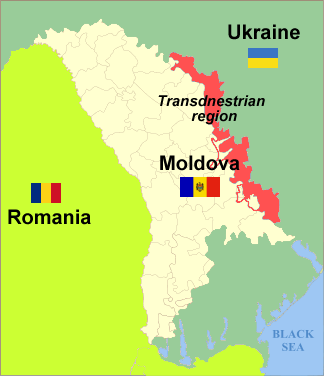Tiraspol
| Tiraspol | |||
|---|---|---|---|
| — Municipality — | |||
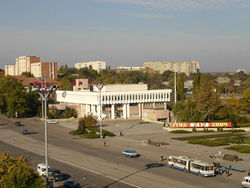 |
|||
|
|||
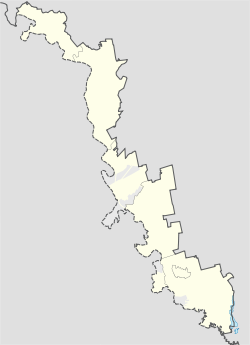 Tiraspol
|
|||
| Coordinates: | |||
| Country | Moldova | ||
| Republic | Pridnestrovian Moldavian Republic (Transnistria) | ||
| Government | |||
| - Mayor | Viktor Kostyrko | ||
| Population (2005) | |||
| - Total | 159,163 | ||
| Area code(s) | + 373 533 | ||
Tiraspol (pronounced /tɪˈræspəl/; Russian: Тирасполь and Ukrainian: Тирасполь) is the second largest city in Moldova and is the capital and administrative centre of the de facto independent Pridnestrovian Moldavian Republic (Transnistria). The city is located on the eastern bank of the Dniester River. Tiraspol is a regional hub of light industry, such as furniture and electrical goods production.
Tiraspol was founded by the Russian general Alexander Suvorov in 1792.[1] The city celebrates its anniversary every year on October 14.[2]
Contents |
Name
The toponym consists of two words: Τύρας, Tyras — the ancient Greek name for the Dniester River, and polis, i.e., a city.
History
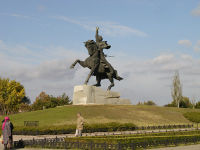
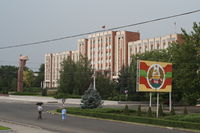
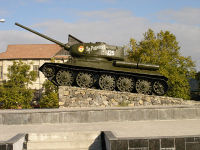

Pre-history
Tyras, or Tiras was a colony of Miletus, probably founded about 600 BCE, situated some 10 km. from the mouth of the Tiras River (Dniester). Of no great importance in early times, in the 2nd century BCE it fell under the dominion of native kings whose names appear on its coins, and was destroyed by the Getae about 50 BCE. In CE 56 it seems to have been restored by the Romans and since then formed part of the province of Lower Moesia. A series of its coins exists, featuring heads of Roman emperors from Domitian to Alexander Severus. Soon after the time of the latter it was destroyed again by the Goths. Its government was in the hands of five archons, a senate, a popular assembly and a registrar. The types of its coins suggest a trade in wheat, wine and fish. The few inscriptions are also mostly concerned with trade. Its remains are scanty, as its site has been covered by the great medieval fortress of Monocastro or Akkerman.[3]
During the Middle Ages, the area around Tiraspol was a buffer zone between the Tatars and the Moldavians, inhabited by both ethnicities.
Foundation
The Russian Empire conquered its way to the Dniester river from Turks and in 1792, the Russian army built some fortifications to guard the western border near a Moldavian village named Sucleia. Field Marshall Alexander Suvorov, who commanded Russian armies, is considered the founder of Tiraspol, and his statue is city's most distinctive landmark. The name was given after the Latin name of the Dniester river ("Tyras") on which it was built.
June 15, 1828: A customs house was established in Tiraspol. The purpose of its creation became suppression of smuggling. This customs house was subordinated to the chief of Odessa customs region. It began operations with 14 employees. They inspected shipments of bread, paper, oil, wine, sugar, fruits and other goods.
XX century - Soviet Tiraspol
The Moldavian Autonomous Soviet Socialist Republic was created in Ukraine in 1924, with Balta as its capital. The republic had Romanian, Ukrainian and Russian as its official languages. Its capital was moved in 1929 to Tiraspol, which remained the capital of the Moldavian ASSR until 1940.
In 1940, following the secret provisions of the Molotov-Ribbentrop Pact, the USSR forces Romania to cede Bessarabia and integrates Tiraspol, until then part of the Ukrainian SSR, into the newly-formed Moldavian SSR.
On August 7, 1941, following the Axis invasion of the Soviet Union, the city was taken by Romanian troops. During the occupation, Tiraspol was under Romanian administration. During that period almost all its Jewish population perished. This same year (before the occupation), the newspaper “Dnestrovskaya pravda” was founded by the Tiraspol City Council of popular deputies. This is the oldest periodical publication in the region.
On April 12, 1944, the city was retaken by the Red Army and became again part of Moldavian SSR.
After independence
On January 27, 1990 A referendum declared that Tiraspol was an independent territory. The nearby city of Bendery also declared its independence. As the Russian-speaking independence movement gained momentum, the local governments banded together to resist pressure from the Moldovan government.
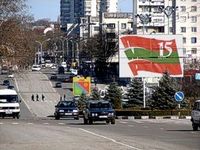
On September 2, 1990, Tiraspol was proclaimed the capital of the new Pridnestrovian Moldavian Soviet Socialist Republic. The new republic was not officially recognized by Soviet authorities, however it received support from some important Soviet leaders, like Anatoly Lukyanov. After the dissolution of the Soviet Union, the territory east of the Dniester river declared independence as Pridnestrovian Moldavian Republic, with Tiraspol as its capital. However, it was not recognized by the international community.
On July 1, 2005, the Lucian Blaga Lyceum, a high school with Romanian as its language of instruction, was registered as a Transnistrian non-governmental establishment. The registration of six Romanian language schools was subject of negotiations since 2000. The tension increased in the summer of 2004, when the Transnistrian authorities forcibly closed the schools that used the Moldovan language in the Latin script, which, according to the official PMR view, is considered as Romanian. Moldovan, written in the Cyrillic script, is one of the three official languages in the PMR. Romanian, however, is not. Some economic measures and counter-measures were taken on both banks of the Dniester.
On July 6, 2006, an explosion, believed to be caused by a bomb, killed at least eight people in a minibus.[4]
On August 13, 2006, a grenade explosion in a trolleybus kills two, injures ten.[5][6][7]
Jewish history
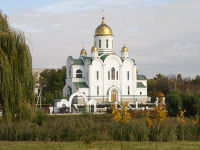
- 1847: Jewish population in Tiraspol amounted to 1,406.
- 1897: Jewish population rose to 8,668 (27% of the total population).
- 1910: Tiraspol had two Jewish private schools, one for boys and one for girls.
- 1926: There were 6,398 Jews (29.1%) in the town.
- 1959: The only synagogue was closed by the authorities. The Jewish population was estimated at about 1,500.
- 1960s and 70s: The Jewish population was believed to be in tens of thousands, out of above 100,000 general population. Yiddish could occasionally be heard on the streets of the city.
- 2007 Jewish population of Tiraspol is 2,200.
Anti-Semitism in Tiraspol
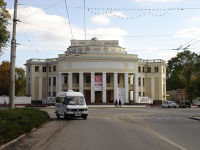
- 14–15 April 2001 the Synagogue of Tiraspol suffered a pipe bomb attack. The building was damaged, but the guard was not hurt.[8]
- 13–30 March 2004 over 70 tombstones in the Jewish cemetery of Tiraspol were vandalized[9] Local community leaders said the authorities refused to help clean up the anti-Semitic graffiti painted over the tombstones[10]
- 4 May 2004, vandals threw a Molotov cocktail in an attempt to set fire to a Synagogue in Tiraspol[10] The attack failed when passers-by extinguished the fire.[11]
Climate
Tiraspol features a humid continental climate that closely borders an oceanic climate. Summers are mild, with average monthly temperatures at around 21 °C (70 °F) in July and August. Winters are cold, with average temperatures in the coldest month (January) at −2.7 °C (27 °F). Precipitation is relatively evenly spread throughout the year, though there is a noticeable increase in monthly precipitation in June and July. Tiraspol on average sees nearly 500 mm (19.69 in) of precipitation per year.
| Climate data for Tiraspol | |||||||||||||
|---|---|---|---|---|---|---|---|---|---|---|---|---|---|
| Month | Jan | Feb | Mar | Apr | May | Jun | Jul | Aug | Sep | Oct | Nov | Dec | Year |
| Average high °C (°F) | 0.7 (33.3) |
2.3 (36.1) |
7.8 (46) |
16.5 (61.7) |
22.5 (72.5) |
25.8 (78.4) |
27.4 (81.3) |
27.3 (81.1) |
23.0 (73.4) |
16.1 (61) |
8.6 (47.5) |
3.3 (37.9) |
15.1 (59.2) |
| Average low °C (°F) | -6.1 (21) |
-4.3 (24.3) |
-0.7 (30.7) |
5.1 (41.2) |
10.3 (50.5) |
13.8 (56.8) |
15.5 (59.9) |
14.7 (58.5) |
10.3 (50.5) |
5.3 (41.5) |
1.3 (34.3) |
-2.8 (27) |
5.2 (41.4) |
| Precipitation mm (inches) | 33 (1.3) |
35 (1.38) |
28 (1.1) |
35 (1.38) |
52 (2.05) |
72 (2.83) |
63 (2.48) |
49 (1.93) |
38 (1.5) |
26 (1.02) |
36 (1.42) |
38 (1.5) |
495 (19.49) |
| Avg. precipitation days | 11 | 11 | 9 | 10 | 11 | 11 | 10 | 7 | 7 | 7 | 11 | 11 | 116 |
| Source: World Weather Information Service[12] | |||||||||||||
Monuments
The statue of Alexander Suvorov was erected in the central square in 1979 in commemoration of his 250th anniversary. In front of the Transnistrian Government building there is a statue of Lenin. On the opposite side of the central square, a monument plaza features a Soviet T-34 tank, commemorating the Soviet victory in World War II, an eternal flame to those who fell defending the city in 1941 and liberating it in 1944, as well as several monuments dedicated to more recent conflicts, including the Soviet war in Afghanistan and the War of Transnistria.
People and culture
Demographics
In 1989 the city had a population of about 190,000 and in 1992 203,000. 41% were Russians, 32% Ukrainians and 18% were Moldovans. As result of the political and economic situation that followed the proclamation of the independent (unrecognized) Pridnestrovian Moldavian Republic, as well as large Jewish emigration in the early 1990s, the population of the city fell below its 1989 number and the 2004 Census in Transnistria puts its current population at 158,069.[13]
| Ethnic composition | |||||
| Ethnic group | 1959 census | 1970 census | 1979 census | 1989 census | 2004 census[14] |
| Russians | N/A | N/A | N/A | N/A | 65,928
41.71% |
| Ukrainians | N/A | N/A | N/A | N/A | 52,278
33.07% |
| Moldovans (Romanians) | N/A | N/A | N/A | N/A | 23,790
15.05% |
| Bulgarians | N/A | N/A | N/A | N/A | 2,450
1.55% |
| Gagauzians | N/A | N/A | N/A | N/A | 1,988
1.26% |
| Belorussians | N/A | N/A | N/A | N/A | 1,712
1.08% |
| Germans | N/A | N/A | N/A | N/A | 701
0.44% |
| Jews | N/A | N/A | N/A | N/A | 573
0.36% |
| Armenians | N/A | N/A | N/A | N/A | 360
0.23% |
| Poles | N/A | N/A | N/A | N/A | 324
0.20% |
| Gypsies | N/A | N/A | N/A | N/A | 116
0.07% |
| others, non-declared | N/A | N/A | N/A | N/A | 7,849
|
| Total | 62,000 | 105,700 | 138,698 | 181,862 | 158,069 |
Sport
There are two professional football clubs in Tiraspol, playing in the Divizia Naţională, the top Moldovan football league: FC Sheriff Tiraspol & FC Tiraspol. Sheriff are the most successful Moldovan football club of recent history, winning every league title since the 2000-2001 season, and 6 Moldovan Cups. A third club, CS Tiligul-Tiras Tiraspol, withdrew from competition prior to the 2009-2010 season. Tiraspol is home to the Sheriff Stadium, the biggest seated stadium in the region with a capacity of 14,300.
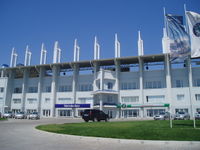
Notable people
- Ion Iovcev
Twin towns — Sister cities
Tiraspol is twinned with:
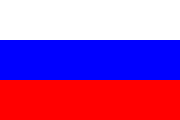 Kaluga, Russia
Kaluga, Russia Severodvinsk, Russia
Severodvinsk, Russia Sukhumi, Abkhazia
Sukhumi, Abkhazia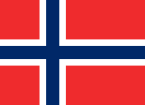 Trondheim, Norway, since 2000[15]
Trondheim, Norway, since 2000[15] Tskhinvali, South Ossetia
Tskhinvali, South Ossetia
References
- Notes
- ↑ About Transdniestra (Russian) World Window NGO. Retrieved 2006, 12-27
- ↑ Street fairs, celebrations mark Tiraspol's 214th birthday Tiraspol Times, Oct 14, 2006. Retrieved 2007, 2-20
- ↑ See E. H. Minns, "Scythians and Greeks" (Cambridge, 1909); V. V. Latyshev, Inscriptiones Orae Septentrionalis Ponti Euxini, vol. I.
- ↑ "Trans-Dniester blast kills eight". BBC News. July 6, 2006. http://news.bbc.co.uk/2/hi/europe/5153322.stm.
- ↑ Regnum: Trolley bus blasted in Tiraspol possibly in a terror attack
- ↑ TiraspolTimes: New bus explosion in Tiraspol leaves one dead, eleven injured
- ↑ Moldpres: Another blast in public transport in Tiraspol
- ↑ Anti-Semitic Incidents Israel Ministry of Foreign Affairs, April 2001
- ↑ Mass Vandalism of Tiraspol Jewish Cemetery Union of Councils for Soviet Jews, April 22, 2004
- ↑ 10.0 10.1 World Briefs Jewish Journal, 2004-05-14
- ↑ Report on Global Anti-Semitism U.S. Department of State, January 5, 2005
- ↑ "Weather Information for Tiraspol". World Weather Information Service. http://www.worldweather.org/108/c01425.htm. Retrieved 6 January 2008.
- ↑ 2004 Census: PMR urban, multilingual, multicultural, from Pridnestrovie.net.
- ↑ 2004 Census in Transnistria, 2004 Census from Pridnestrovie.net
- ↑ Trondheims offisielle nettsted - Vennskapsbyer
External links
Non-Transnistrian links
- (Polish) Tyraspol (Tiraspol) in the Geographical Dictionary of the Kingdom of Poland (1892)
- Current weather at Tiraspol from Yahoo
- Article about travelling to Tiraspol at Lonely Planet
- Tiraspol on Google Maps
- Tiraspol telephone directory
- Yellow pages of Tiraspol
Transnistrian links
- VisitPMR.com (government-registered (ICDISS-funded) travel information website)
- Tiraspol.info (in Russian)
|
|||||||||||||||||||||||
|
||||||||||||||||||||
|
|||||||||||||||||
|
|||||||||||||||||||||||


